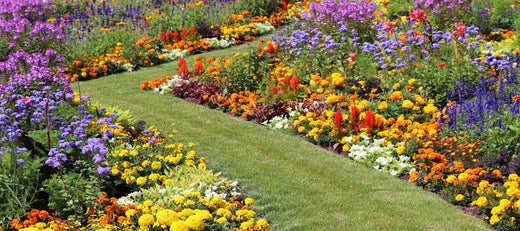As the crisp air of fall sets in, many gardeners are busy putting their gardens to bed for the winter. However, fall is also an ideal time to plant seeds that will reward you with a spectacular display of flowers come spring and early summer. Certain flower seeds, especially those that benefit from cold stratification, thrive when sown in the fall. These seeds are programmed to endure winter's chill and will burst into bloom when warmer weather returns. Let’s explore some of the best flower seeds from Survival Garden Seeds to sow this fall for a colorful garden next year.
Best Seeds to Sow in Fall for Spring and Early Summer Flowering
Forget-Me-Not

Best for: Northern and Northeastern U.S., Pacific Northwest, Midwest, Mountain West (USDA Hardiness Zones 3-8)
Forget-Me-Nots are beloved for their delicate, sky-blue flowers that brighten up any garden. These charming plants are perfect for borders and shady spots, and they typically bloom in early to late spring. Forget-Me-Not seeds benefit from cold stratification, which you can achieve by sowing them in the fall.
Columbine

Best for: Northern U.S., the Rockies, Pacific Northwest. (USDA Hardiness Zones 3-8)
Columbine flowers are a favorite perennial among gardeners and pollinators alike, thanks to their unique shape and vibrant colors. Fall sowing is particularly beneficial for Columbine, as it allows the seeds to undergo cold stratification, breaking their dormancy and encouraging healthy germination in late spring.
Lupine

Best for: Northern U.S., Pacific Northwest, Mountain West (USDA Hardiness Zones 4-8)
Lupines are known for their tall, striking flower spikes and come in various colors, including purple, pink, blue, and white. These flowers thrive in cooler climates. Lupine seeds benefit significantly from cold stratification. When planted in well-drained soil with plenty of sunlight, lupines can create a spectacular display from late spring into early summer. They are also excellent for attracting pollinators like bees and butterflies.
Coneflower (Echinacea)

Best for: Various Regions (USDA Hardiness Zones 3-9)
Coneflowers are hardy perennials that produce striking blooms in various colors, attracting bees and butterflies. Coneflower seeds benefit greatly from cold stratification, making fall an excellent time to sow them. This ensures robust growth and vibrant flowering by early summer.
Shasta Daisy

Best for: Various Regions (USDA Hardiness Zones 4-9)
Shasta Daisies, beloved perennials with their classic white petals and bright yellow centers, thrive when planted in the fall. The cold period helps them to establish strong roots early and prepare for a delightful show of cheerful flowers.
Sweet William

Best for: Northern U.S., Midwest, Pacific Northwest (USDA Hardiness Zones 4-8)
Sweet William adds a splash of color to any garden with its fragrant clusters of flowers. This biennial prefers cooler climates and benefits from fall planting. Sweet William is part of our Cut Flowers Wildflower Mix and our Hummingbird Pollinator Mix.
Lavender

Best for: Western U.S., Southwest (USDA Hardiness Zones 5-9)
Known for its aromatic foliage and beautiful purple blooms, lavender is a must-have for any garden. While lavender doesn’t strictly require cold stratification, sowing in the fall can help improve germination rates, especially in colder climates. Lavender planted in the fall will establish itself well and bloom beautifully by summer.
California Poppy

Best for: Western U.S. and Coastal Regions (USDA Zones 6-10)
California Poppies are perfect for fall planting in regions with mild winters. These hardy annuals thrive in well-drained soils and bloom in vibrant shades of orange, yellow, and red. They are drought-tolerant and ideal for adding a pop of color to spring gardens.
Sweet Alyssum

Best for: Southern U.S. (USDA Zones 7-11)
Sweet Alyssum is a low-growing flower that forms a dense mat of small, fragrant blooms. It thrives in warmer climates and can be sown in the fall for a burst of spring color. It's especially well-suited for borders and ground cover.
Snapdragons

Best for: Southern U.S. and Coastal Regions (USDA Zones 7-10)
Snapdragons can be sown in the fall in regions with milder winters. They will overwinter and produce an abundance of blooms in early spring. Available in a variety of colors, they add vertical interest to garden beds.
Preparing Your Garden Beds for Fall Sowing
To ensure your fall-sown seeds get off to the best possible start, proper bed preparation is key. Start by choosing a well-drained location that receives the appropriate amount of sunlight for your chosen flowers. Clear the area of any weeds and debris, and work in some organic matter, such as compost, to enrich the soil. Loosen the soil to a depth of about 6-8 inches to create a good environment for seed germination and root development. After sowing your seeds, lightly cover them with soil or mulch, depending on the specific needs of each variety. Water the area gently and lightly to help the seeds settle into the soil.
Tips for Successful Fall Sowing
Timing is everything: Sow seeds near the first frost but before the ground freezes. This timing allows seeds to settle into the soil and ensures they are not tempted to sprout during a late warm spell in the fall. For regions without a hard frost, plant as soon as cooler, consistent fall temperatures set in.
- Mulch for protection: A thin layer of mulch can help regulate soil temperature, retain moisture, and protect seeds during the winter months.
- Label your plantings: It’s easy to forget where you’ve sown seeds, especially over the winter. Mark your plantings with labels to remember where each variety is located.
- Watering: Water the soil lightly after planting to help settle the seeds in. However, avoid overwatering, as excessive moisture can lead to seed rot. After the initial watering, let nature take its course with fall and winter precipitation.
- Patience is key: Remember that some seeds may take longer to germinate than others. Be patient and wait for the warmer spring temperatures to encourage growth.
By choosing the right seeds and following these tips, you can set the stage for a stunning display of flowers come spring and early summer. Happy fall planting!























